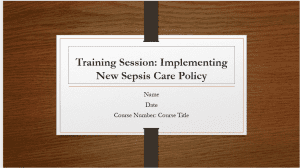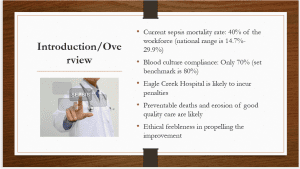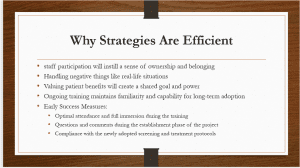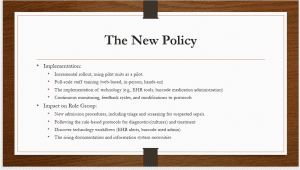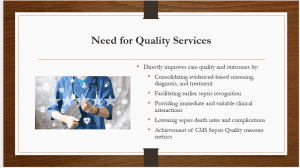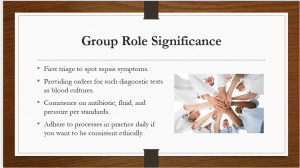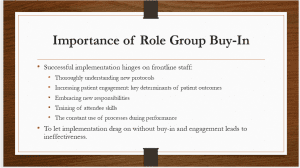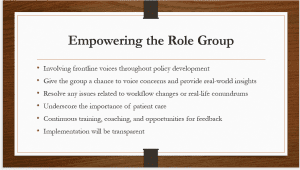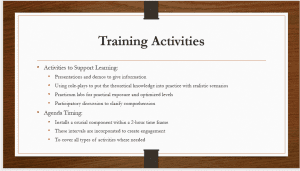Training Session- Implementing New Sepsis Care Policy
Hello. Welcome to today’s training session on implementing the new sepsis care policy.
What makes this new sepsis prevention program more significant? Today, we are facing the crisis of our unit’s mortality rate of sepsis, which is 40%. This is radically more than the 14.7% to 29.9% range that has been observed nationally. Moreover, in approximately 70% of investigated sepsis cases, blood cultures are not taken prior to the administration of antibiotics; therefore, the 80% CMS criterion is missed in the vast majority of cases.
This failed certification puts us in the position where Eagle Creek Hospital can be liable for heavy financial penalties from CMS, yet worse still, this means preventable deaths and erosion of good quality care is a probability that is not supposed to take place. In the light of health care providers, ethical responsibilities require the full-scale implementation of evidence-based policies and strategies tailored to maximize patient recovery rates in sepsis.
To secure the involvement of the frontline clinical staff to effectively implement the new sepsis protocols, we will employ several evidence-based tactics. The first step involves involving the selected physicians, nurses, and support staff in the actual development of protocols to include their perspectives and expertise. We anticipated and proactively dealt with the workflow concerns that were raised within the teams or presented a bottleneck, improving processes wherever necessary. An important point of emphasis was that the sepsis guidelines are not only beneficial to patients but that they also remain in line with our objectives. Ultimately, we have come up with a comprehensive training program, which will include ongoing mentorship and technical support to enable quick adoption and sustainability of use.
These strategies are highly successful primarily because they involve the end-users, are based on pain point resolution, appeal to the instinct of a provider to deliver quality services and sustain long-term behavior change. When staff are committed to building protocols up, they are already vested and more likely to have a better implementation of those protocols. All problems related to workflows must be addressed early before they annoy the employees. Reminding healthcare providers of the patient’s benefits is an effective strategy that reaffirms the shared mission and purpose. Meanwhile, job shadowing, training, tools, and coaching transfer knowledge and skills to last over time. Some first signs of the successfulness of these methods will be a high level of attendance at training, the reaction and questions in policy development, and the actual compliance rates with newly adopted screening and treatment protocols.
The new policy will be introduced gradually and take effect on the different units through a progressive rollout, starting with pilot areas. This leads us to refine processes prior to scaling up the service more broadly. We provide extensive training to staff on all affected roles, an element that comprises web-based modules, classroom classes, and hands-on practice. We don’t want to have problems after we go live; therefore, proficiency is an imperative priority. In addition, we leverage technology solutions such as EHR tools for sepsis screening and clinical decision support, as well as barcode medication administration. Even though our solution has been implemented, we will still measure the performance, get feedback on mistakes, and fix them quickly in an agile fashion. However, the frontline clinical roles will involve taking up the responsibility of triage and screening cases of sepsis. We must comply with the step-by-step, evidence-based protocols such as timely blood culture collection and healthcare interventions. The process and documentation requirements will be affected as there is integration of EHR tools and barcoding workflows. Nevertheless, these improvements have the capacity to reduce mistakes and further enhance care quality.
These new sepsis protocols are extremely crucial for providing the best possible patient support and bringing in good outcomes. Establishing protocols based on scientific evidence for screening, detection, and paths to treatment is essential to move further. The protocols encourage prompt identification of sepsis by appropriate triage and subsequent monitoring. When sepsis is diagnosed promptly, medical personnel can apply treatment promptly – fluids, vasopressors, cultures, and the right antibiotic. The prompt treatment helps against entering the septic shock phase and multiorgan failure. By following these standards, sepsis-preventable deaths and patient complication rates are significantly reduced. Apart from the organizational perspective, it also helps us achieve CMS standards as well as quality measures. Our focus, however, is on giving our patients better outcomes, which will equally strengthen our reputation and financial position by providing quality care.
Working as a clinician on the frontline plays a key role in the successful implementation of these new sepsis guidelines. Consequently, we almost immediately become the first defense. Recognizing the signs and symptoms of sepsis as part of triage and screening is our responsibility to make a diagnosis. In this situation, we are the first to obtain necessary laboratory exams such as blood cultures and give antibiotics according to the standard protocols. Should sepsis be diagnosed; therefore, we enact and guide the approved treatment algorithms around antibiotics, fluids, vasopressors, and other lines of treatment. Also, the protocols must be applied at every patient encounter – not occasionally, but at everyone’s treatment. It is crucial for our daily tasks involving methods and procedures to be followed attentively to have a successful sepsis care initiative with improved quality standards.
The sustainability of these new sepsis protocols mainly depends on getting the entire staff on the same page and keeping everyone fully involved. First, we need to be fully informed of the clinical and operational evidence-based protocols— we should know which ones are beneficial, why they are beneficial, and how to approach them. We will also need to embrace the concept of sepsis care improvement as something that is pivotal, and the steps towards it will yield satisfaction and successful community members. A reassessment of such responsibilities as triage, screening, treatment, and documentation procedures needs to take place. Attending and participating in the training sessions as well as the provision of coaching opportunities that are a necessity of getting the required skills is mandatory. Last but not least and by far most crucial, we should ensure the implemented protocols are strictly applied each time without fail during our daily work and patients’ encounters. To continue the momentum of the action, the plan should be implemented; otherwise, progress will be stopped. Lastly, all frontline workers should be entirely committed to this project to ensure a victorious implementation. This cannot be realized through the imposition of regulating schemes only.
To empower the group and earn that needed buy-in, we could utilize an inclusive and transparent approach. To begin with, participants from the key nursing, physician, and support staff should be directly involved in every stage of policy development. This team would make significant contributions towards this protocol; hence, they have a voice. Accordingly, placing emphasis on resolving any issues related to workflow changes or real-life conundrums we might encounter during this process is critical. Besides, recommendations from all group members will help improve the policy/guideline. The focal point of this communication is to underscore the importance of patient care and tie these new processes to the core mission and reason of health providers. Training is just a beginning point – we’ve implemented a continuous education, coaching, and feedback mechanism, which can lead to additional support and the possibility of raising issues as they occur. Implementation will also be done transparently. The results of these protocols on our sepsis care quality metrics and outcomes will be reflected in our analysis. This also indicates the gravity of the issue. Conclusively, we could conduct a speedy appraisal and incorporate any frontline recommendations with regard to the improvement of the protocol.
The varied training activities are strategically designed to build and reinforce knowledge and skills. The lectures and practical demonstrations reinforce the latest sepsis policy, the protocols, and the workflow of technology. Furthermore, the role-play scenarios offer an opportunity to put knowledge to work and overcome difficulties in a supported setting. Practical skills, such as blood culture collection, are like reinforcement of competencies since they build one’s confidence. Eventually, the segments in which we are open to dialogue enable us to reinforce skills via interactive dialogue and Q&A sessions. Regarding the schedule, we have configured the key matters into a 2-hour frame using the breaks for the maintenance of a high level of engagement. Nevertheless, we’ve put in such measures to be able to stretch out the activities in case they need more time during the execution phase.
ORDER A PLAGIARISM-FREE PAPER HERE
We’ll write everything from scratch
Question
Design a training session presentation (8-12 slides) for one of the role groups in the organization that will be responsible for implementation.
Collapse All
Introduction
Training and educating those within an organization who are responsible for implementing and working with changes in organizational policy is a critical step in ensuring that prescribed changes have their intended benefit. A leader in a healthcare profession must be able to apply effective leadership, management, and educational strategies to ensure that colleagues and subordinates will be prepared to do the work that is asked of them.
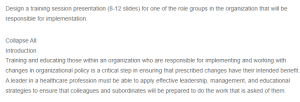
Training Session- Implementing New Sepsis Care Policy
As a master’s-level health care practitioner, you may be asked to design training sessions to help ensure the smooth implementation of any number of initiatives in your healthcare setting. The ability to create an agenda that will ensure your training goals will be met, and will fit into the allotted time, is a valuable skill for preparing colleagues to be successful in their practice.
This assessment offers you an opportunity to develop and implement effective educational strategies.
Instructions
To help ensure a smooth rollout and implementation of your proposed policy and practice guidelines, design a training session presentation for one of the role groups in the organization that will be responsible for implementation.
Provide a brief summary of your strategies for working with your chosen role group.
Explain the impact of the new policy on the group and the importance of the change to improve the quality of care.
Explain how the group is important in implementing your proposed policy and practice guidelines and why you chose this group to pilot your proposal.
Determine appropriate instructional content and explain to the group the learning activities and materials they should expect during the training session.
Prepare an annotated agenda for a two-hour training session.
During this training session, you will want to ensure that the individuals you are training understand the new policy and practice guidelines. You will need them to buy into the importance of the policy in improving the quality of care or outcomes and their key role in successful policy implementation. You must help them acquire the knowledge and skills they need to be successful in implementing the policy and practice guidelines.
As an outcome of this training session, participants are expected to:
Understand the organizational policy and practice guidelines to be implemented.
Understand the importance of the policy to improving quality or outcomes.
Understand that, as a group, they are key to successful implementation.
Possess the necessary knowledge and skills for successful implementation.
Requirements
The strategy summary and annotated training agenda requirements outlined below correspond to the scoring guide criteria, so be sure to address each main point. Read the performance-level descriptions for each criterion to see how your work will be assessed. In addition, be sure to note the requirements for document format and length and for supporting evidence.
Summarize evidence-based strategies for working with the role group to obtain their buy-in and prepare them to implement the new policy and apply the associated practice guidelines to their work.
Why will these strategies be effective?
What measures might provide early indications of success?
Explain the impact of the new policy and practice guidelines.
How they will be implemented?
How will they affect the daily work routines and responsibilities of the role group?
Justify the importance of the new policy and practice guidelines with regard to improving the quality of care or outcomes related to the role group’s work.
How will the policy and guidelines help improve the quality of care or outcomes?
Explain the role group’s importance in implementing the new policy and practice guidelines.
Why is the work and buy-in of the role group important for successful implementation?
How could you help the group feel empowered by their involvement during implementation?
Determine appropriate and effective instructional content, learning activities, and materials for the training session.
How will each proposed activity on your agenda support learning and skill development?
Can you complete the training within the allotted two hours?
Deliver a persuasive, coherent, and effective audiovisual presentation.
Be sure that the information and arguments you present are aligned with the needs of your audience.
Review the organization of your slides for clarity.
Proofread your slides to minimize errors that could distract the audience or make your message more difficult to understand.
Presentation Format and Length
You may use Microsoft PowerPoint or other suitable presentation software to create your slides. If you elect to use an application other than PowerPoint, check with your faculty to avoid potential file compatibility issues.

